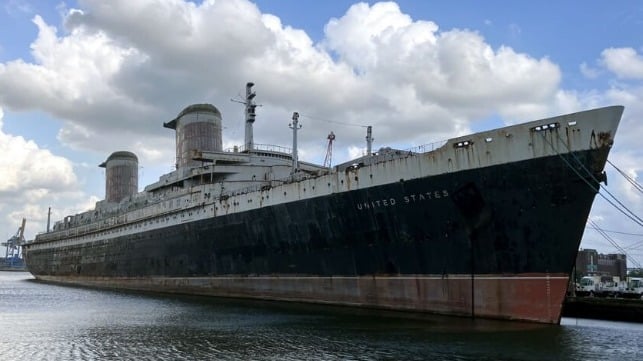Court Rejects Bid to Delay Date to Finalize Plan to Move SS United States

The S.S. United States Conservancy lost its latest court bid to extend the date to move the once famed ocean liner from its pier in Philadelphia. The nonprofit had asked the court to give it till December to finalize arrangements to remove the ship from the pier it has been at for the past 28 years with the court rejecting an extension but creating a little extra space for the efforts.
The group has been involved in a fight with its landlord Penn Warehousing over an effort to increase the rent for the dock and for potential damages to the pier. They won on those claims but Judge Anita Brody told the Conservancy it could not stay at the pier forever and it had till September 12 to remove the ship. In a ruling today for the motion to extend the date till December, the judge said she feared granting an extension would only lead to another request for an extension. She told the court, “We all have to live in realism.”
The Conservancy said it has been unable to secure a new pier although unconfirmed reports are that some potentials might still be willing. In the court filing, they admitted the Philadelphia Navy Yard does not have space at the government-controlled berths while port authorities in Virginia, Maryland, North Carolina, South Carolina, and Georgia have been dead ends.
The organization confirmed it is in discussions with two Florida countries, Escambia and Okaloosa, about reefing the 990-foot ocean liner, but while they said a deal was being negotiated, the group contends both are reluctant because of the short timeline for removal. Contractors hired by Okaloosa County have been on the vessel on two occasions to evaluate the extent and cost of environmental remediation associated with a reefing project. Escambia has also identified a potential reefing site and initiated testing, and advanced towing and other potential arrangements.
Among the challenges they point to is it would take 10 to 14 days of towing to move the liner from Philadelphia to Pensacola, Florida. Reports said the counties are reluctant because of the short time window and concerns about moving the vessel during hurricane season.
They also site challenges such as getting U.S. Coast Guard approval for the move and the need for stability assessments. The Conservancy told the court it has engaged in preparations including obtaining a hydrographic survey of the water depth around the vessel and pier. It is coordinating a vessel inspection with its insurance carrier and following up on the insurer’s recommendations for a tow. Alternate discussions are also underway with potential scrappers.
The Conservancy questioned a declaration from Penn Warehousing that Hyundai Glovis is interested in using the pier for offloading cars from its Ro/Ros. Also, they cited a threat from the landlord to impose a $3 million penalty if the ship is not removed by September 12.
“Penn Warehousing hopes to bankrupt the Conservancy, whose precarious financial situation Penn Warehousing recognizes, and seize the ship in the process,” the Conservancy wrote in its court filing. In a letter attached to an earlier court filing, Penn Warehousing offered the Conservancy to hand over the title and walk away from the ship with no further obligations.
The judge agreed that the September 12 deadline could be for the Conservancy to finalize a plan for the vessel and not for the removal. The Philadelphia Inquirer report suggests Penn Warehousing would be willing to negotiate a lease extension with the new owners of the ss United States once a deal is struck to transfer ownership.
The Conservancy in its court filing said along with Okaloosa County they have “pursued extensive negotiations on the terms of a written contract acceptable to both parties, which the parties are close to finalizing.”
The ss United States remains one of the last examples of a trans-Atlantic ocean liner from the heyday of passenger shipping. The Conservancy had hoped to find development partners to convert the vessel into a multiuse attraction.
